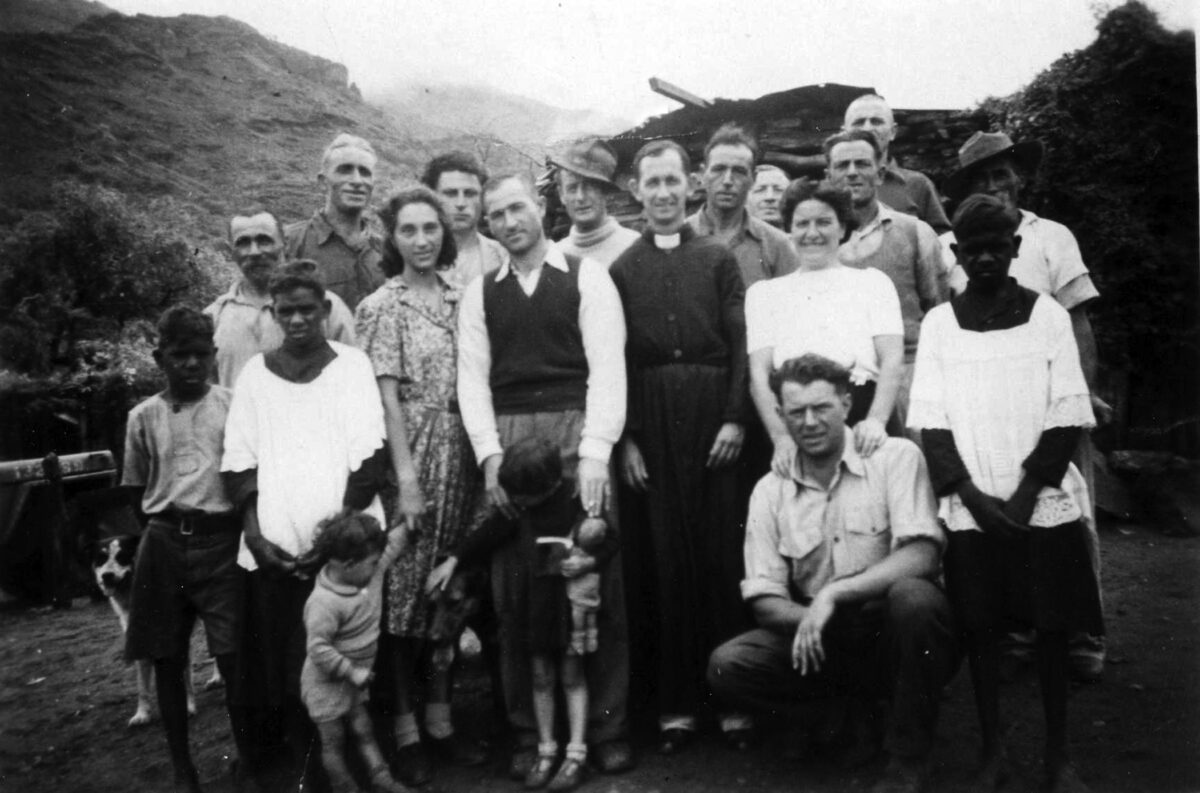In the photo above, Serafina and Attilio De Pieri hold their children, Freddy and Adelina, in a group with a visiting priest, Billy Hughes mica mine, 1945.
In a blog in 2019, I wrote about the Veneto market gardener men who lived and worked on the mica mines in the Northern Territory in the Harts Ranges about 215 kilometres north-east of Alice Springs. These men included Angelo and Attilio Piovesan, Gelindo Rossetto and his brothers, Angelo and Beppi.
Women in the mica mine camps
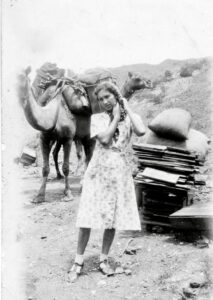
In this blog I focus on the Veneto women who embarked on a dramatic adventure joining their husbands in the remote desert country where the mica mines were located without the comforts of electricity and adequate water and where they lived in makeshift accommodation. One of the earliest Veneto women in the mica mines was Serafina De Pieri who was featured in a 2022 blog. Serafina became well known in the Veneto community in Adelaide because of her significant role on the Social Committee of the Veneto Club in the late 1970s and early 1980s.

Research about the mica mines*
In 1995, David Hugo wrote a thesis about migrant people who worked on the mica mines at Harts Ranges. His research showed that most of the miners were Italian and many post-war migrants went to the mines attracted by relatives or paesani who had reported the adventure and good income from mining mica.
As part of his research, David Hugo recorded oral history interviews with several women and men who had lived and worked on the mines from the 1930s to the 1950s. His research showed that women played a vital role in the camps often working with men. In their oral history interviews, people had spoken about the close interaction with Aboriginal people who helped with different tasks in the camps and provided their local knowledge about terrain, water and conditions of desert life.
Women’s memories of the mica mines
David Hugo wrote about the perceptions of women who lived on the mines which differed from those of the men. The women he interviewed included: Serafina De Pieri, Teresa Fadelli, Italia Floreani, Antonietta Mamone and Mary Rigoni. He speaks about their accounts:
They tended to present a fuller picture of mica mining as a way of life rather than concentrating on the specifics. They told of the difficulties of raising families and undertaking all housekeeping, at the same time as working alongside their husbands and fathers. They performed such tasks as trimming, cutting and grading the mica; and, in some cases, were expected to even do the work of the men underground. They related moments of sorrow following miscarriages; of having to go back to the mining camps against medical advice; and of the sadness felt when leaving very young children in Alice Springs to be cared for and educated by the Church … it is clear from the transcripts that the women showed humour, courage and strength in dealing with the hardships … Above all, there emanated an inescapable commitment to family, friends,
and to a better life. (p 224)
Serafina De Pieri nee Corletto
The story of Serafina offers an insight into the life of a young woman who arrived in Australia in 1939 as a new bride, aged 20 years old. Her husband, Attilio, had worked in a mica mine for several years before the couple married in Italy and went to live at Harts Ranges.

Serafina lived at the mine until 1942 when she and Attilio moved to Adelaide where their first two children, Adelina and Fred were born. The family went back to the mine in 1945 for three years and then they returned to Adelaide. The youngest child, Roberto, was born in 1950.
Everyday life of women in the camps
Women prepared the food for their own families and also for single men if they lived in the camps. The diet combined tinned meat and vegetables bought on the visits to Alice Springs every three or four months when the miners sold their mica to the Commonwealth Mica Buyer. Other food, like pasta and dried fish, came from Italian grocers in Adelaide. Serafina De Pieri recalled that after a bore was sunk at the Billy Hughes mine where she lived with her husband for some time, they were able to grow lettuce, beans, peas, cauliflowers, cabbages and even watermelons. They had to protect the plants from kangaroos and goats. The men ordered large barrels of wine from Patritti Wines in Adelaide and bottled it in the camps.

People in the camps kept herds of goats which were for milk and meat. Serafina recalled that they experimented with cooking wild life even galahs, “Yeah, we try eating them once, the young one, but it’s not much good.” Serafina also spoke about preparing kangaroo for meals . . . “the tail, we make a beautiful soup. The leg, you make a beautiful chop, or cutlet … with the flour and eggs.”
Post World War II Veneto migrants
In their oral history interviews, a number of people in the Veneto market gardeners’ project spoke about their own experience or about their father’s life and work on the mica mines. The two following descriptions provide images of what it was like to be a woman living in a mining camp in remote desert country.
Armida Mattiazzo arrives in 1952
Armida Biasetto arrived in Australia in 1952, aged 24 years. Soon after she married her fiancé, Augusto Mattiazzo, in Melbourne, they went to live and work at the ‘Last Chance’ mica mine in the Harts Ranges. Augusto had already worked there for some time with other Veneto men.
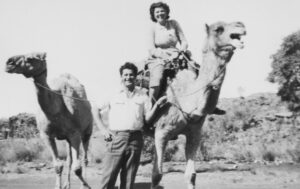
In 2016 Armida was interviewed by Eleonora Marchioro and recalled her early years in Australia and the mica mine:
When I arrived in Alice Springs, for me it was a big thing especially the trip to get to Alice Springs, it took eight hours in those times with a plane … we had to stop three or four times. When we arrived in Alice Springs we went to friends and we stayed there for two or three days and then we left with a jeep and went to the [mine] and it took 11 or 12 hours and I arrived and I was in the desert … there was no bitumen roads. They were tracks made by people driving up and down with trucks. I was never desperate, I always liked it but I was young and I had a young husband.
I had a good life there… there was nothing to clean because [laughs] there was dust everywhere… I was the only woman, and at night they used to prepare the yeast for the bread and after in the morning they used to go up to the mine…
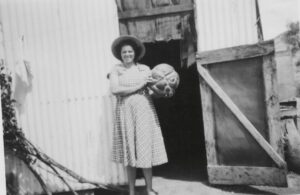
And I used to stay down at the camp and I used to get the bread which was baked underground. It used to take an hour and the bread would be ready. At ten in the morning, I used to bring them tea and I used to make little cakes because I knew my husband liked them. I used to bring this for the friends and they came down for lunch at 12.00… And at night, it was always a party.
I stayed four years but my husband was there for seven years.
(Armida Mattiazzo nee Biasetto, OH 872/112, 1 December 2016, pp 3, 4, 5)
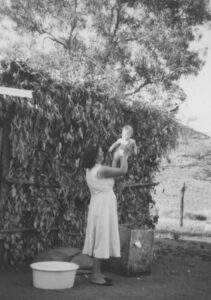
After a difficult birth in the Alice Springs hospital, Armida’s first baby died. Armida and Augusto’s son, Denny, was born in 1954 before the couple decided to live in Adelaide where their daughter, Adelina, was born in 1956.
Bruna Rossetto nee Battaglia moves to the mica mine
Bruna had arrived in Australia in 1939 and after she married Giuseppe (Beppi) Rossetto in 1943, they had three children, Val, Allan and Denis, and for some time Giuseppe worked in the Spotted Tiger mica mine with his brother, Gelindo Rossetto. In the following extract, Bruna explains that she decided to go and live with Beppi on the mine in about 1951:

I was there living Liverpool Street with my three children, trying to work and go and help a little bit in the factory and I was, I been working all the time, but then after I started to feel lonely for him. I didn’t like the idea just being by myself with the kids there, I wanted to go up in the mine. He didn’t want me to. He said, ‘It’s not a life for you up there with the kids, it’s not a life,’…

Val was about six years old when she went to the convent in Alice Springs, she was a boarder there, and I took my two boys in the Spotted Tiger Mine … I stay there for two, three years. I cooked for 12 men and had kids to look after.
(Bruna Rossetto nee Battaglia, OH 872/33, 18 December 2014, pp 4-5, 18)
The accounts of their lives in the mica mines reflect the strength and resilience of the Veneto women who took on new roles in unfamiliar circumstances in the Australian desert. They created family life without the social supports they might have had in their village in the Veneto region or that they might have found in Adelaide. They lived without the comfort of amenities and managed their daily lives in basic conditions. Indeed, they showed courage and commitment to their new life.
Madeleine Regan
18 June 2023.
*Thesis, “Mica Mining at Harts Range Central Australia, 1880s – 1960: A Study of Ethnicity and the Impact of Isolation,” by David Frederick Hugo.
You can access the thesis here: https://ris.cdu.edu.au/ws/portalfiles/portal/23680670/Thesis_CDU_6115_Hugo_D.pdf
